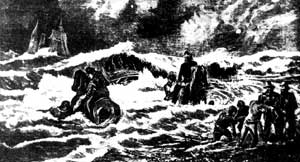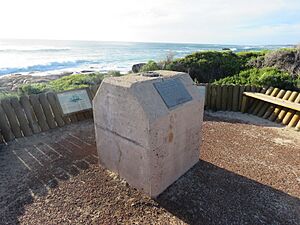SS Georgette facts for kids
class="infobox " style="float: right; clear: right; width: 315px; border-spacing: 2px; text-align: left; font-size: 90%;"
| colspan="2" style="text-align: center; font-size: 90%; line-height: 1.5em;" | 
|} The SS Georgette was a steamship built in 1872. A steamship is a boat powered by a steam engine, rather than just sails. The Georgette is famous for its part in the exciting Catalpa rescue in April 1876. Eight months later, the Georgette itself was involved in a dramatic shipwreck. Even though its time sailing along the coast of Western Australia was short, the Georgette was an early example of how steamships would take over from sailing ships.
Contents
| History | |
|---|---|
| Launched | 1872 |
| Fate | Sank 1876 |
| General characteristics | |
| Tonnage |
|
| Length | 46.2 m (152 ft) |
| Beam | 6.9 m (23 ft) |
| Draft | 3.4 m (11 ft) |
| Propulsion |
|
The Georgette's Story
The Georgette was built in 1872 in a place called Dumbarton. It was an iron screw-steamer weighing 337 tons. The ship was 46.2 metres long, 6.9 metres wide, and 3.4 metres deep. It was designed to be a collier, which is a ship that carries coal. It could carry 460 tons of cargo. The Georgette had two engines that produced 48 horsepower. It also had two masts with a schooner rig, meaning it could use sails too.
When the Georgette was still quite new, it was sold in England for £14,000 to buyers in Western Australia. It arrived in Fremantle, Western Australia in September 1873. The ship then started working as a trading and passenger service along the coast. It sailed between Fremantle, Albany, and Champion Bay. In October 1873, the ship got stuck on the Murray Reef. It had to be sent to Adelaide for repairs. The Georgette was back in service by March 1874.
The Catalpa Rescue
In April 1876, an American whaling ship called the Catalpa helped a group of Fenian political prisoners escape from Fremantle. These prisoners were fighting for Irish freedom. The Catalpa had dropped its anchor in international waters, which means it was outside the control of any country. It sent a small boat to shore to pick up the escapees.
The escape was noticed while the prisoners were still rowing back to the Catalpa. The Georgette, which was in Fremantle, was sent with a police boat to stop them. However, the prisoners successfully reached the Catalpa. Since the Georgette had no official orders to board the Catalpa, it and the police boat turned back.
The next morning, the Georgette returned and demanded that the prisoners be given back. The Catalpa's captain, George Anthony, said he did not have the prisoners on board. He also pointed out that his ship was in international waters. The Georgette then fired a warning shot with its small cannon. But Captain Anthony pointed to his ship's US flag and sailed away. The Georgette chased the Catalpa until it ran low on fuel. Then, it had to return to Fremantle.
The Georgette's Final Voyage
On November 29, 1876, the Georgette left Fremantle for its last trip. It was carrying fifty passengers and a load of jarrah wood. The ship was heading to Adelaide, stopping at places like Bunbury, Busselton, and Albany.
Just after midnight on December 1, when the Georgette was between Cape Naturaliste and Cape Hamelin, a leak started. The ship's pumps did not work. By 4 a.m., water was filling the ship so quickly that Captain John Godfrey had everyone bailing water out with buckets. He tried to steer the ship towards the coast. At 6 p.m., the rising water put out the engine's fires. This left the Georgette drifting a few kilometres from shore.
Captain Godfrey then ordered everyone into the lifeboats. But the first lifeboat to be lowered was hit by a big wave and broke in half. Some people from that boat were saved by a second lifeboat, but twelve people sadly died.
A Heroic Rescue
The Georgette kept drifting until it reached the waves at Calgardup Bay. There, it was seen by Sam Isaacs, an Aboriginal stockman from the Bussell family. Sam rode to the Bussell home to get help. Alfred Bussell gave him ropes and gear for the rescue. His 16-year-old daughter, Grace, insisted on going with Sam back to the beach on horseback.
Meanwhile, the Georgette had hit the seabed and was starting to break apart. When they arrived, Grace Bussell immediately rode her horse down the cliffs and into the waves. She swam her horse out until it was next to one of the lifeboats that was full of water. With as many people as possible holding onto her and her horse, she rode back to shore and helped them land safely. One man was still on the boat, and Sam Isaacs went to rescue him.
Captain Godfrey kept trying to launch lifeboats, but each one filled with water or flipped over in the waves. Grace Bussell and Sam Isaacs kept working to save people. It took them over four hours to bring all the passengers safely to shore.
Grace Bussell's brave actions were reported all over the world. She was called "Western Australia's Grace Darling" and received a silver medal for her bravery. Sam Isaacs received a bronze medal and was given 100 acres of land by the government. This made him the first Aboriginal person to receive a land grant in Western Australia. Captain Godfrey, however, faced a lot of criticism for the shipwreck. His captain's certificate was taken away, but he managed to get it back later.
One of the people who survived the sinking was George Leake, who later became a leader in Western Australia.
The remains of the Georgette's hull were sold for £40. Today, the wreck lies in five metres of water, about 90 metres off Redgate Beach. The site is protected by law.



